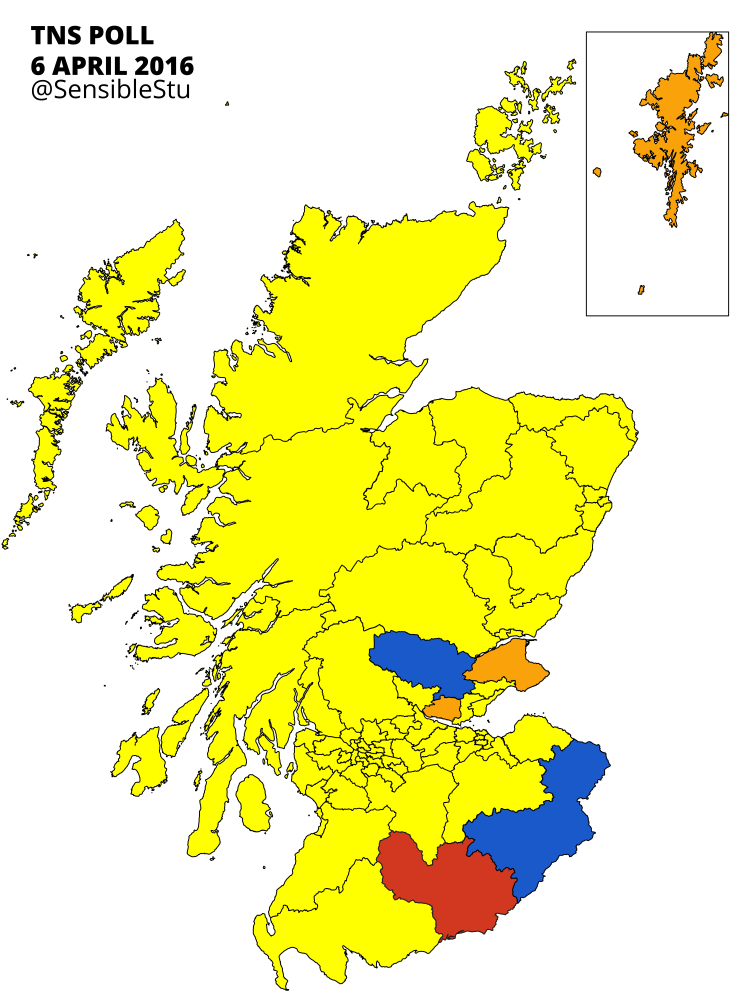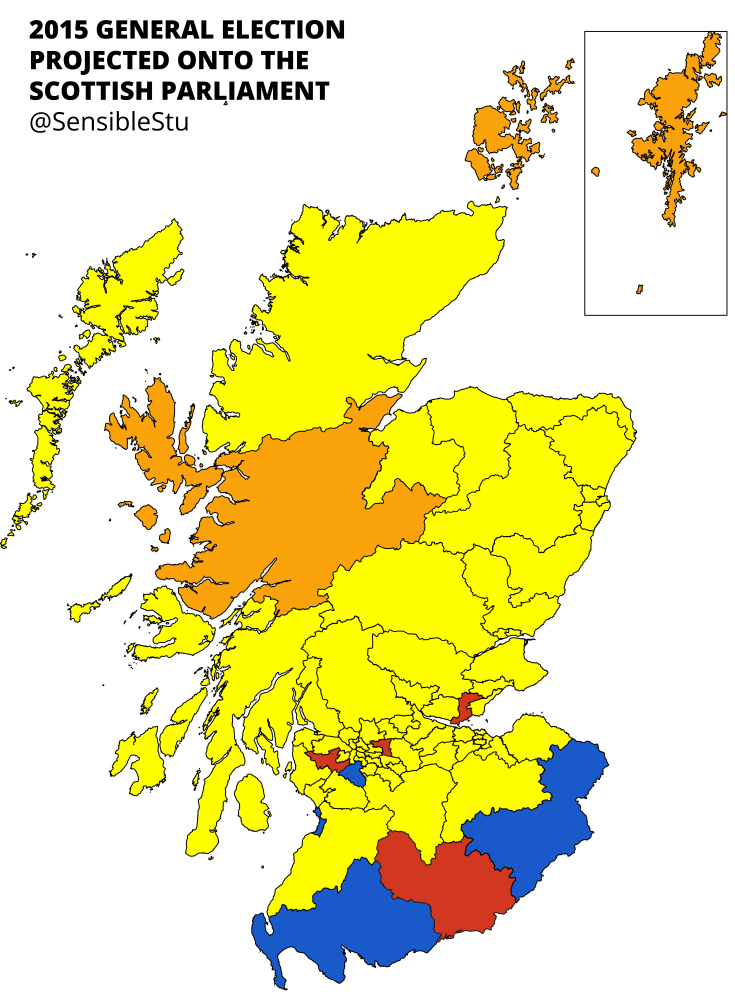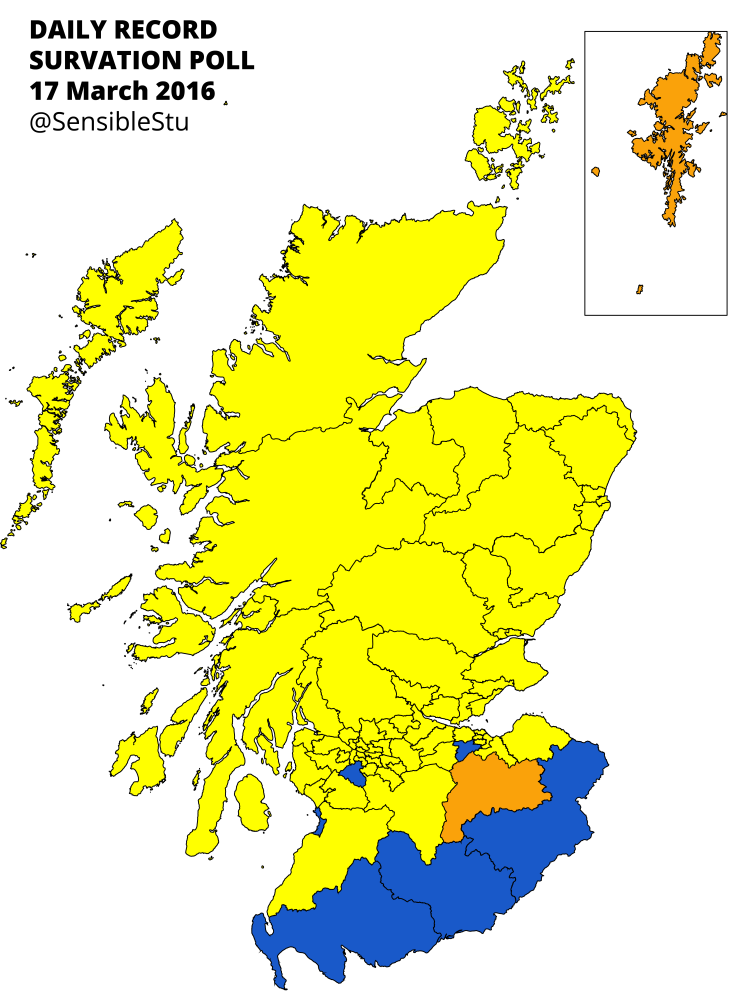Projection: SNP majority of 13; Labour on 26
 SNP: 71 (+2)
SNP: 71 (+2)
Labour: 26 (-11)
Conservative: 19 (+4)
Lib Dem: 5 (-)
Green: 7 (+5)
UKIP: 1 (+1)
Last week’s TNS poll will bring some relief to Scottish Labour. Cutbot’s UNS based projector forecasts a respectable (relative to expectations) seat tally of 28 for Labour, my own projection based on regional breakdowns forecasts 26 seats for Labour.
On TNS’ figures, the SNP look set to win 67 out of 73 constituency seats, with Labour retaining only Dumfriesshire. While the Tories lose Galloway and West Dumfries, and Ayr, they make a surprising gain by unseating Roseanna Cunningham in Perthshire South and Kinross-shire. Perhaps even more surprisingly, however – despite losing Liam McArthur in Orkney, the Lib Dems re-take both North East Fife AND Dunfermline! If that actually happens, I’ll eat Paddy Ashdown’s hat.
The regional list picture is a little bit more muddled, with Labour polling abysmally in the Highlands and Islands, and North East, but actually outpolling the SNP, 43% to 41%, in Glasgow. If these numbers are reflect in votes cast next month, then the Highlands and Islands will become the first ever region to have no Labour MSPs whatsoever. In Glasgow, Labour picks up an impressive six regional list seats, with a further five in Central and West – all very much at the very top-end of expectations. Labour drops to two seats in Mid Scotland and Fife, North East, and Lothians – making Sarah Boyack Labour’s highest profile casualty.
Having dominated the constituencies in most regions, and with less impressive vote shares in the two regions where their constituency hegemony is fettered, the SNP only picks up four regional list seats, bringing their total seat tally to 71.
While the Tories could expect no fewer than eleven new faces among their group, on these numbers, Adam Tomkins won’t be one of them. UKIP picks up a single seat in the North East, with their Scottish Leader David Coburn missing out on a seat in the Highlands and Islands.
The Greens are polling strongly in the Lothians, as you would expect, easily picking up two seats in the region. On TNS’ numbers the Greens could also expect two seats in the Highlands and Mid Scotland and Fife. Though instinctively unlikely in reality, strong numbers in Mid Scotland and Fife have featured very frequently in the polls in the run up to this election – I’m starting to think there might be something in it.
There are some close contests. On the basis of these numbers, Labour’s best chances of retaining seats (other than Dumfriesshire) are Glasgow Provan, Rutherglen, and East Lothian. The Tories only take Perthshire South by a whisker, while losing Ayr and Galloway by even smaller margins. The Lib Dems, only scrape through in each of the three seats they’re forecast to win.
Perhaps the most interesting figures are in the SNP’s vote shares, which I’ll go into in some more detail next time.

 The extrapolation sees another SNP near clean-sweep. Labour retains four constituencies: Coatbridge and Chryston; Cowdenbeath; Dumfriesshire; and Renfrewshire South. The Lib Dems retain their present two seats, and retake Ross, Skye, and Lochaber. The Tories retain their present three seats and gain Eastwood. In addition to those seats that change hands, the model produces a number of close contests: Edinburgh Central, Southern, Pentlands, and Western; Glasgow Provan; Dunfermline; Kirkcaldy; Aberdeen Central; Aberdeenshire West; East Lothian; and Dumbarton. If anyone is expecting some surprise results in May, they’ll likely come in one of those seats.
The extrapolation sees another SNP near clean-sweep. Labour retains four constituencies: Coatbridge and Chryston; Cowdenbeath; Dumfriesshire; and Renfrewshire South. The Lib Dems retain their present two seats, and retake Ross, Skye, and Lochaber. The Tories retain their present three seats and gain Eastwood. In addition to those seats that change hands, the model produces a number of close contests: Edinburgh Central, Southern, Pentlands, and Western; Glasgow Provan; Dunfermline; Kirkcaldy; Aberdeen Central; Aberdeenshire West; East Lothian; and Dumbarton. If anyone is expecting some surprise results in May, they’ll likely come in one of those seats. SNP: 69 (-)
SNP: 69 (-)